 Emerson Fittipaldi in his heyday |
Source: http://blogs.espnf1.com/paperroundf1/archives/2010/11/five_ways_to_improve_f1.php
 Emerson Fittipaldi in his heyday |
Source: http://blogs.espnf1.com/paperroundf1/archives/2010/11/five_ways_to_improve_f1.php
 As a sign of design and financial strength the Volkswagen Group will premier up to seven concept vehicles at next month's Geneva Motor show.
As a sign of design and financial strength the Volkswagen Group will premier up to seven concept vehicles at next month's Geneva Motor show.Jaime Alguersuari Philippe Alliot Cliff Allison Fernando Alonso
I'm converting a 1/24 diecast into a sorta-replica of a car I once owned ... a light yellow 1967 Chevelle with a black vinyl top. I've got a very close match spray can of yellow which I'll apply via airbrush - but what's the best way to duplicate the vinyl top? I'm considering plain old (wide) masking tape painted with Tamaya semi-gloss black. Do I need to paint the top yellow before applying the tape? If not, will overspray show thru the tape when its pressed down? I'm doing this "on the cheap," so I really don't want to order aftermarket material for the top. Ideas? Suggestions?
Thanks!
Source: http://cs.scaleautomag.com/SCACS/forums/thread/842555.aspx
Source: http://joesaward.wordpress.com/2011/02/02/global-open-wheeler-racing-in-2011/
I'll make this as simple as possible.
There will be two teams bearing the Lotus name in Formula 1 next year.
One, following Wednesday's announcement of Lotus Cars' decision to sponsor and eventually buy into what was the Renault team, will be called Lotus Renault. That team will be part-owned by Lotus Cars but their F1 cars will be called Renaults and will use Renault engines.
The other will be called Team Lotus. This one has nothing to do with Lotus Cars (any more - but we'll come back to that in a moment) but their F1 car will be called a Lotus. They will also use, er, Renault engines.
Both teams, it transpires, plan to run their cars in variations of a black and gold livery. This is an attempt to hark back to the historic John Player Special livery made famous by the original Team Lotus in the 1970s and 1980s through great drivers such as Emerson Fittipaldi, Mario Andretti, Ronnie Peterson, Nigel Mansell and Ayrton Senna, and era-defining cars like the Lotus 72 and 79.
It's a commentator's - and journalist's - nightmare and one can only begin to imagine the confusion it will create for those watching.
So what on earth is going on?
The story starts in 2009, when Malaysian businessman Tony Fernandes obtained a multi-year licence from Lotus Cars to use the Lotus name in F1, having persuaded the Malaysian-owned company that an involvement in grand prix racing would be a valuable promotional tool.
Lotus Racing were one of three new teams in F1 in 2010, the others being Virgin and Hispania. All three spent the year close to the back of the grid, but Lotus did establish themselves as convincingly the most competitive.
In order to see this content you need to have both Javascript enabled and Flash installed. Visit BBC Webwise for full instructions. If you're reading via RSS, you'll need to visit the blog to access this content.
In the course of the year, though, Group Lotus's approach to F1 changed, as part of a hugely ambitious refocusing of the company's future plans by chief executive officer Dany Bahar, who formerly worked in the commercial arms of Red Bull F1 and Ferrari.
Bahar, it transpires, was never keen on Lotus granting the licence to Fernandes, and it has become clear through 2010 why - he wanted to take the brand into F1 himself, but in a different way, through an involvement with an established team.
At the Paris Motor Show in October, Bahar announced plans for five new road-car models, expanding Lotus's range by nearly 200%, and has since said Lotus will enter IndyCar racing in the US and race at Le Mans. And now comes a major sponsorship deal with what used to be the Renault F1 team which will, at an undefined point in the future, morph into Lotus part-owning that team.
Fernandes, meanwhile, struck a deal in September to buy the rights to the Team Lotus name from David Hunt, brother of 1976 world champion James. Hunt had bought them when the original Team Lotus collapsed in 1994 after racing in F1 since 1958, during which time it had established itself as one of the sport's most iconic names.
Fernandes' success in buying the name - exclusively revealed by BBC Sport - marked the point at which what had until then been a private dispute between him and Lotus Cars - which is owned by the Malaysian company Proton - broke out into the open.
Following Fernandes's acquisition of the Team Lotus name, Group Lotus claimed that it owned all the rights to the Lotus name - a point of view robustly disputed by Hunt, who points out that Proton have several times tried to buy the Team Lotus name from him without ever being able to conclude a deal.
The dispute got so heated that former Malaysian Prime Minister Mahatir bin Mohamad stepped in to mediate, but he succeeded only in stopping the ping-pong of press releases. The dispute is now going to the High Court - and it is unlikely to be resolved until next year.

Bahar (left) launches a new Lotus car with the help of actress Sharon Stone. Photo: Getty
But the disagreement over the ownership of Team Lotus is only one of two ongoing legal cases between Lotus Cars and Fernandes. In the other, Fernandes is suing Lotus Cars for breach of contract over its withdrawal of the licence to use the Lotus name in F1.
That, too, is not expected to be resolved until some time next year.
Both sides, then, have got themselves into a bit of a pickle.
Lotus Cars has struck a deal to promote its brand in F1 through a team that is knocking on the door of breaking into the top three - and which, in Robert Kubica, has one of the finest drivers on the grid.
But it is doing so with a car that is called a Renault - and there is no way out of that one.
Lotus and the team's majority shareholder, the private investment group Genii Capital, cannot change the constructor name assigned to their team because if they do so without the permission of all the other teams they will lose the millions the team earns through Renault's historic achievements in F1, which date back to their entry in 1977.
And guess which team would not agree?
Fernandes, meanwhile, faces the prospect of his team giving free publicity to a company with which he is in two separate legal disputes. And even if he changed the name of the team to something else, his cars would still be called Lotuses.
It is an unsatisfactory situation for all involved - the efforts of both parties will be diluted by a dispute that, for those watching, will create only confusion.
Fernandes is understood to be increasingly confident that he will win the court case over the Team Lotus name. Lotus Cars, for its part, appears not to be overly concerned about the existence of a second team diluting its brand. Their view is that only one of the teams is affiliated with Lotus, and the other one is providing free advertising for it.
In the meantime, questions hang in the air.
Is the end game for Fernandes to sell the Team Lotus brand to Lotus Cars if he succeeds in establishing that he owns it? Can Lotus - and its parent company Proton - sustain such an ambitious programme? And so on.
In the murk, only one thing seems clear - this is only the latest stage in a story that will rumble on for some time to come.
Source: http://www.bbc.co.uk/blogs/andrewbenson/2010/12/lotus_v_lotus.html
Enrico Bertaggia Tony Bettenhausen Mike Beuttler Birabongse Bhanubandh
 Fernando Alonso is the new favourite for the title |
?He is the man with the momentum and, on the same basis that I backed Mark Webber to win the title before Korea, is now my favourite to claim the world title in Abu Dhabi on Nov 14. ?When the cars are so evenly-matched you have to back the man in possession. Especially when that man is a two-time world champion and arguably the finest driver of his generation.?The Mirror?s Byron Young drew comparisons between Alonso and seven-time world champion Michael Schumacher as the Spaniard bids to become the sport?s youngest ever triple world champion.
?Like Schumacher, Alonso accepts no opposition within his team. Ultimately he fell out with McLaren over their refusal in 2007 to bring Lewis Hamilton to heel. ?He returned to Renault on condition he was No.1, only to be at the centre of the Singapore cheat scandal - engineered to hand him victory. ?The Spaniard has always denied involvement but at the German GP in July he was brazen enough to radio Ferrari to rein in team-mate Felipe Massa so he could start the winning streak that has taken him to the brink of history.?
Source: http://blogs.espnf1.com/paperroundf1/archives/2010/10/alonso_the_new_favourite_1.php
Sebastian Vettel was crowned the youngest world champion in history after a memorable final twist at the Abu Dhabi Grand Prix, but was he the best driver of the year?
It's a subjective question, and so difficult after such a momentous season that I have been wrestling with it for some weeks.
Does Vettel's pace in the dominant Red Bull mean he was Formula 1's top driver? How does that rank alongside the performances of Lewis Hamilton and Fernando Alonso in inferior cars?
What about Robert Kubica's ability to mix it with the title contenders in the Renault? Or Kamui Kobayashi's attacking verve in the Sauber?

Vettel is centre-stage among the class of 2010 - but is he number one in our list? Photo: AFP
Here is my list of the top 10 drivers of 2010:
10) After battling for the title with Brawn in 2009, it cannot have been easy for Rubens Barrichello, at 37 going on 38, to drum up the enthusiasm for a season battling to make the top 10 in qualifying with once-great Williams.
But drum it up he did, impressing the team with his technical feedback and producing some excellent drives that resulted in strong points positions when Williams had something of a purple patch mid-season.
The veteran Brazilian was outshone by rookie team-mate Nico Hulkenberg at times as the German found his feet late in the season.
Nevertheless, as he heads into an astonishing 19th F1 season in 2011, Barrichello clearly still has a lot to offer.
9) Kamui Kobayashi emerged as one of F1's most exciting talents with some all-action performances in 2010.
Overtaking is notoriously difficult but the Japanese simply went for it, finding unconventional passing places to liven up such races as Valencia and Japan.
There remain doubts about his ultimate potential, with Sauber drafting in the reliable Nick Heidfeld for the final five races of the season to give Kobayashi a benchmark to measure himself against.
But Kobayashi responded perfectly and gives all the signs of having a great future.
8) It all started so well for Felipe Massa, who out-qualified new team-mate Alonso at the first race of the season. But when Alonso passed the Brazilian around the outside of the first corner, it set the tone for the entire year.
Alonso trounced Massa in 2010, proving faster than him at virtually every race, and there is no doubt the Spaniard's relentless excellence got to the man in the second Ferrari.
There were some good drives from Massa - particularly his third places at Monza and Korea. But he will have to pull something very special out of the bag, not to mention rediscover his mental equilibrium, to reverse this trend in 2011.
7) Nico Rosberg convincingly beat Mercedes team-mate Michael Schumacher this year and, had he achieved that feat 10 years ago, there would have been no doubt he had emerged as a truly great F1 driver.
But the Schumacher of this year was not the same driver as before, as even the seven-time champion himself effectively admitted.
Rosberg drove a strong season, and some good races, and there are an increasing number of people in F1 who believe he is emerging as a top-class contender.
But until he goes up against - and beats - a driver of the highest calibre, it will be hard to tell whether he deserves to be considered as that himself, or whether he is nearly there, but not quite.
6) Not even Jenson Button probably expected to be leading the championship after winning two of the opening four races of 2010 and out-qualifying McLaren team-mate Hamilton 3-1.
Button's two victories in the wet in Australia and China owed a lot to clever strategic calls but that was not all. The sight of Button pulling away from Hamilton in China on a wet track and on tyres of comparable age proved once and for all that this is a driver of the very highest calibre.
After that, Hamilton got on top and stayed there but Button, who was rarely very far away in qualifying and often more or less matched his team-mate on race pace, provided a convincing answer to those who said he had gained his 2009 triumph more by luck than ability.
5) Mark Webber chose the name Aussie Grit for his Twitter account, and 2010 proved why. Expected to fulfil the role of an obedient number two at Red Bull, Webber went toe-to-toe with team-mate Vettel throughout the season and led him in the championship for most of it.
After a shaky first couple of races, Webber came on song when the season came back to Europe with dominant wins in Spain and Monaco that left Vettel bemused at where his team-mate had found such electrifying pace.
By mid-summer, Vettel had got his edge back, but Webber remained large in his mirrors, ready to take advantage of any mistakes. That he was able to do this despite suspicions that Red Bull were not perhaps being quite as even-handed in their treatment of their drivers as they insisted was all the more impressive.
But his challenge faded in the end, crashing in Korea and failing to make any real impact in the final two races of the campaign.
4) Did Renault's Robert Kubica perform better than any other driver on the grid when you consider the equipment he had at his disposal?
You can certainly make that case. No-one else can claim to have made so few mistakes while extracting what appeared to be the maximum from his machinery.
The Renault was not fast enough for Kubica to regularly mix it with the title contenders but on three occasions he transcended the car's limitations in a way only the truly great can - at Monaco, Spa and Suzuka, F1's three great drivers' circuits.
To qualify second in Monaco, third in Spa and fourth in Suzuka was a momentous achievement - and he backed that up by taking podium places in both Monaco and Belgium before being robbed of another when his wheel came loose in Japan.
There is still a slight question mark over a man who, in 2009, was not able to comprehensively overshadow Heidfeld at BMW. And let's not forget that Kubica was not burdened with the kind of pressure that the likes of Alonso, Vettel, Button and Hamilton were.
But put Kubica in a competitive car and all his rivals would fear him.
In order to see this content you need to have both Javascript enabled and Flash installed. Visit BBC Webwise for full instructions. If you're reading via RSS, you'll need to visit the blog to access this content.
3) Sebastian Vettel is a great talent and a deserving world champion but, considering the stunning pace of the Red Bull car, he should have won many more races and clinched the title much sooner.
The car's fragility did not help - failures in Bahrain, Australia, Spain and Korea cost him a lot of points - but the German also made a number of high-profile errors. He crashed into rivals in Turkey and Belgium, suffered a puncture following a red-mist moment at Silverstone and was penalised for misjudging the safety car in Hungary.
Ten pole positions and five wins speak for themselves to an extent but, as the (slightly) faster driver in comfortably the fastest car, they are to be expected.
Some of those pole laps were stunning, though, with Vettel possessing an Ayrton Senna-esque ability to pull that little bit extra out on his very final lap, no matter what the circumstances, while each one of his wins was a masterpiece of domination.
However, there have to be fewer mistakes, more wins dragged out of adversity and more convincing performances when he is back in the pack for him to be ranked above the next names on the list.
2) Had this article been written after the Belgian Grand Prix, Lewis Hamilton would have occupied the number one spot.
Up to that point, Hamilton had made not a single mistake worth the name and he was leading the championship in what had from the mid-point of the season been the third fastest car.
Hamilton had maintained his exuberant, attacking style and stunning natural pace and had mated it to a consistency that was making him a formidable competitor.
His fantastic victory at Spa - not forgetting the qualifying lap that earned him second on the grid on slicks in a shower of rain - confirmed him as the outstanding driver of the season to that point, notwithstanding the canny Button's two wet wins.
Suddenly, though, it all went wrong. Hamilton crashed out of the next two races in Monza and Singapore and when he crashed again in Friday practice at the next race in Japan his season appeared to be coming apart at the seams.
But then came one of the laps of the season - third on the grid at Suzuka in a car in which he had done just six flying laps before qualifying. It was a reminder of Hamilton's amazing talent. By then, though, as far as the championship was concerned, the damage had been done.
1) Fernando Alonso's first year with Ferrari started with a few shaky races and finished with a strategic mistake that cost him the title. In between the Spaniard did just enough to earn the right to call himself the best driver of 2010.
Early-season errors were born of trying too hard in a car that was not quite on the pace. Combine that with Ferrari losing their way for a while and Alonso was 47 points off the lead at the midpoint of the season.
But in a car that established itself as the second fastest behind the Red Bull, he recovered that margin by driving with a consistent, relentless brilliance that his rivals were not able to match. His victories at Monza and Singapore were stunning. Only Hamilton at Spa and perhaps Webber at Monaco can claim a performance of comparable quality.
That ultimately Alonso did not win a third title was only because of his team's error in Abu Dhabi. For the 2005 and 2006 champion, as he said himself, it was still a great year.
Source: http://www.bbc.co.uk/blogs/andrewbenson/2010/11/who_were_the_top_10_f1_drivers.html
Source: http://adamcooperf1.com/2011/02/02/chandhok-awaits-team-lotus-confirmation/
Gerhard Berger Eric Bernard Enrique Bernoldi Enrico Bertaggia


Michael Schumacher has admitted he "feels good" about his decision to race in Formula One again.
The German driver, who won the world Drivers' Championship seven times, has had a disappointing 2010 season. He had been expected to challenge for the title but ended the season ninth in the standings with 72 points.
He couldn't even beat his team-mate Nico Rosberg, who ...
Source: http://feedproxy.google.com/~r/Formula1Fancast/~3/XPnEyiQ-Rws/michael-schumacher-has-no-regrets
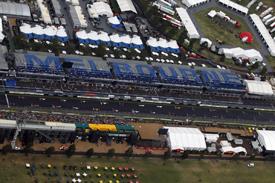
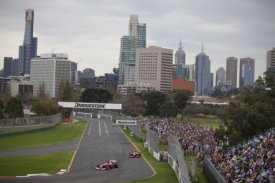
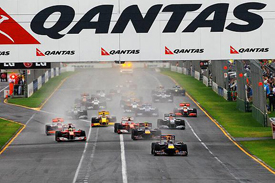
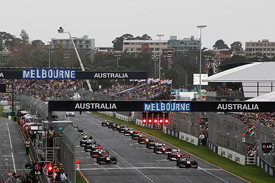 Australian GP has full support of Victoria By Jonathan Noble Wednesday, February 2nd 2011, 12:19 GMT The Australian Grand Prix has been given assurances that it will continue to receive the full support of the Victoria government - despite recent doubts about the future of the event. Speculation about the long-term viability of the Melbourne event surfaced recently after Melbourne's mayor questioned whether the grand prix was good value for the city. However, at an official launch for the 2011 race, Victoria's state tourism minister Louise Asher said there was no doubting its own commitment. Related posts:
Australian GP has full support of Victoria By Jonathan Noble Wednesday, February 2nd 2011, 12:19 GMT The Australian Grand Prix has been given assurances that it will continue to receive the full support of the Victoria government - despite recent doubts about the future of the event. Speculation about the long-term viability of the Melbourne event surfaced recently after Melbourne's mayor questioned whether the grand prix was good value for the city. However, at an official launch for the 2011 race, Victoria's state tourism minister Louise Asher said there was no doubting its own commitment. Related posts:Source: http://doxcar.com/f1-australian-gp-has-full-support-of-victoria/
Source: http://feedproxy.google.com/~r/f1fanatic/~3/nO28sYuQNSo/
The agreement for Formula 1 to switch to a new energy-efficient type of engine in 2013, exclusively revealed by BBC Sport, is the culmination of months of in-depth negotiations about one important aspect of the future of the sport.
Increasing F1's sustainability was a key aim of both Jean Todt - the president of governing body the FIA - and the Formula 1 teams through their umbrella organisation Fota, and this move certainly makes a statement about that.
By replacing the current 2.4-litre normally aspirated V8 engines with 1.6-litre, four-cylinder turbos with energy recovery and fuel restrictions, F1 has deliberately mirrored the way road-car manufacturers are taking the cars we all drive on the road.
Fossil fuel supplies are running out and there is an ever-increasing pressure on resources, but there is no realistic replacement in sight for the internal combustion engine for some time to come, despite the hopes for zero-emission hydrogen fuel cell engines, for example.
In those circumstances, car manufacturers have no choice but to produce ever-more efficient engines.
That is already happening with 'hybrid' cars such as the Toyota Prius and an increasing number of manufacturers rolling out energy-saving technologies across their ranges.
But the manufacturers involved in F1 hope that by adopting these technologies in a glamorous, high-profile activity they can speed up their adoption by making them 'sexy'.
So whereas now high-performance and fuel economy/efficiency are regarded among the wider public as pretty much mutually exclusive, F1 can prove otherwise and by extension help in dramatically reducing the carbon dioxide emissions produced by road cars in the future.
They will do this by producing new engines that reduce fuel consumption by as much as 50% while retaining the same power and keeping competition as close as it has been in 2010.
It is not all about philanthropy, though. Inevitably, there is self-interest involved too.
F1 is aware that it has an image for being profligate with resources. In an era when there is increasing pressure on energy supplies, it is nervous about its position as an activity that literally burns fossil fuels for fun.
By introducing these new rules, F1 is hoping it can go some way towards insulating itself against accusations that it is an irrelevant waste of resources.
It can counter any such claims by pointing out that the pursuit of the maximum possible power output for the minimum possible fuel consumption by some of the world's brightest engineers in the white-hot competition of F1 will lead to a much faster development of energy-efficient technologies.
These advances will thus transfer much more quickly to road cars than they would have done, thereby reducing global CO2 emissions quicker than if F1 had not bothered.
It is a noble idea and it sounds like a no-brainer - and regular readers of this blog may remember that I wrote about the likelihood of these rules as long ago as April - but there have over the past few months been serious doubts about whether they would be adopted in 2013, as was originally the plan.
That is because as F1's power-brokers began to discuss the idea, economics and politics threatened to put the brakes on it.
The move was opposed for some time by Mercedes and Ferrari because they felt it did not make any sense to commit to spending millions designing a new type of engine at a time when the sport was trying to cut costs, and teams were facing problems finding sponsorship as the global economic crisis bit.

F1 cars last used turbos in the '80s - they are coming back for 2013 in a very different form. Photo: Getty
Better, some felt, to delay such a big change by a year or two - or perhaps even five - and make some nods towards efficiency with the current engines, than embark on such a complex programme at such a difficult time.
How, these people argued, would they convince the boards of major car companies to spend anywhere between 50-100 million euros building new engines for F1 when the current ones worked perfectly well and all car manufacturers were struggling financially?
There were other objections, too.
The background to the talks was that the 2010 F1 season was developing as one of the greatest in the sport's history, with five drivers in three teams competing for the world championship.
All involved were painfully aware that it would be foolish to introduce a new regulation that put the closeness of competition at risk.
F1 commercial boss Bernie Ecclestone put it this way to me when I spoke to him about the prospect of the new rules: "It's not necessary. We have a very good engine formula. Why should we change it to something that is going to cost millions of pounds and that nobody wants and that could end up with one manufacturer getting a big advantage?
"We don't need to do it; all the manufacturers are doing it (in their road cars) already."
At the same time, F1's senior figures were aware that while the current 2.4-litre V8 engines might appear to be wasteful, in actual fact they are more efficient in terms of specific fuel consumption - the amount of power produced per unit of fuel - than any road-car engine.
The counter-arguments to these objections were as follows:
Nevertheless, even the most ardent proponents of the new rules recognised that those arguing against had a point - no one had an appetite to spend tens of millions of euros on a new F1 engine and no one wanted to wreck the on-track show.
As a result, I'm told, a series of checks and balances have been built into the new rules to ensure that the engine manufacturers cannot engage in a spending war and to prevent one of them gaining a significant performance advantage over the others.
It was also recognised that an F1 car had to remain what it is - super-fast, with a very powerful engine. So the new engines will produce about the same total power output, 750bhp, as the current ones.
How they do it, though, will be very different.
Only 600bhp of that will come from the 1.6-litre, four-cylinder turbo engine itself; the remainder will be generated by the energy recovery systems that will be integrated within it. Fuel consumption will be restricted both by limiting fuel flow and introducing a maximum capacity for races.
Current engines rev to 18,000rpm - a figure that has come down from more than 20,000rpm in recent years as the FIA has introduced limits as part of cost-saving moves. The new ones will not do more than 10,000rpm.
That in itself caused concern - believe it or not, there was disquiet that the new engines would not sound 'right', that they would be too quiet.
Anyone who has witnessed an F1 car at close quarters will be aware that they make a quite shattering noise - few things on this earth are louder.
Certainly, the new ones will sound different - and quieter - but whether that is better or worse depends on your point of view. It is almost certainly also a question that concerns the ardent F1 fans who live for the sport a lot more than it does the millions more who switch on their televisions every other weekend to watch a race.
It sounds almost surreal to think that this was a serious point of discussion among such serious-minded people, but I can assure you it was.
Whatever your take on it, though, the new engines have won the day, and their adoption will be announced sooner rather than later, even if it is not after the FIA World Council meeting on Friday 10 December, as I'm told it could well be.
This, though, is just the first of many sets of talks about the future of F1.
To come are negotiations over a new Concorde Agreement, the document that binds together the teams, the FIA and the Formula 1 Management (FOM) companies, represented by Ecclestone, and which runs out at the end of 2012.
The teams are pushing hard for their split of the sport's huge revenues to increase from 50% to 75%, and early indications are the FIA is also seeking a major shift in its relationship with FOM.
If talks over a new engine formula felt difficult and protracted, those over the new Concorde Agreement promise to be something else again.
Source: http://www.bbc.co.uk/blogs/andrewbenson/2010/12/f1_moves_to_set_green_agenda.html
Mario Andretti Michael Andretti Keith Andrews Elio de Angelis
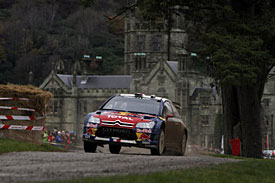
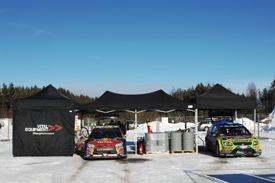 Rally GB future to be discussed By David Evans Tuesday, February 1st 2011, 11:39 GMT The immediate future of Rally Great Britain will be discussed - along with all rounds of the World Rally Championship -when the WRC's promoter North One Sport presents its 2012 calendar to the WRC Commission, now headed by president Jarmo Mahonen, in Paris on Wednesday. Following tomorrow's discussion, the calendar will then be put forward to the FIA World Motor Sport Council meeting next month, when it's hoped it will be rubber-stamped as one of the earliest approved calendars ever Related posts:
Rally GB future to be discussed By David Evans Tuesday, February 1st 2011, 11:39 GMT The immediate future of Rally Great Britain will be discussed - along with all rounds of the World Rally Championship -when the WRC's promoter North One Sport presents its 2012 calendar to the WRC Commission, now headed by president Jarmo Mahonen, in Paris on Wednesday. Following tomorrow's discussion, the calendar will then be put forward to the FIA World Motor Sport Council meeting next month, when it's hoped it will be rubber-stamped as one of the earliest approved calendars ever Related posts:Source: http://doxcar.com/wrc-rally-gb-future-to-be-discussed/
Source: http://feedproxy.google.com/~r/formula-f1/~3/ZnrxkxHJshc/
Source: http://motorcycling.speedtv.com/article/bikes-playboy-models-ride-at-cornerspin/
Posted on 02.1.2011 13:00 by Simona
Filed under: Brabus Mercedes | sedan | Mercedes S-Class | luxury cars | car tuning | Cars | Car Reviews | Brabus
Brabus has announced an impressive tuning package for the Mercedes S350 BlueTec equipped with the Euro VI exhaust emission standard. Thanks to a ECO PowerXtra D6S performance kit, the model delivers an extra 54 HP and an extra 70 NM of torque.
The ECO PowerXtra D6S kit’s performance increase depends on the selected shift mode of the 7G-TRONIC PLUS automatic transmission. In ?Eco? mode the maximum power output of the engine remains unchanged, but the peak torque jumps from standard 457 to 509 lb-ft. Upon switching to ?Manual? or ?Sport? mode, the increase in torque is accompanied by an increase in maximum power output from 255 HP to 308 HP at a low 3,600 rpm.
Equipped with the kit, the S350 will sprint from 0 to 60 mph in just 6.5 seconds, while top speed remains limited to 155 mph.
The same kit is also available for all four body styles of the Mercedes E 350 CDI BlueEFFICIENCY and for the new CLS 350 CDI BlueEFFICIENCY model.
Press release after the jump.
Mercedes S 350 BlueTec by Brabus originally appeared on topspeed.com on Tuesday, 1 February 2011 13:00 EST.
Source: http://www.topspeed.com/cars/brabus/2011-mercedes-s-350-bluetec-by-brabus-ar104331.html
Source: http://adamcooperf1.com/2011/02/01/schumacher-finally-the-waiting-is-over/
Source: http://f1fanatics.wordpress.com/2011/01/07/button-steps-up-pre-season-training-with-lance-armstrong/